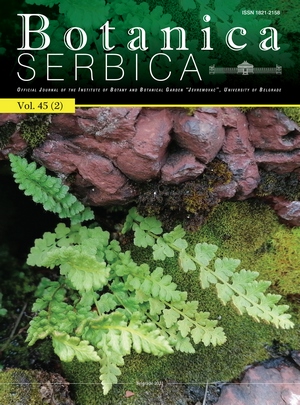
Volume 45 Issue 2 2021 |
Diversification of yellow-flowered Sempervivum (Crassulaceae) species from the Balkan Peninsula: evidence from the morphometric study of the epidermal structures of rosette leaves
|
KEY WORDS: Sempervivum ciliosum complex, Sempervivum ruthenicum complex, epidermal cells, stomata, trichomes |
The formation of integuments, megasporogenesis and megagametogenesis in Dendrobium catenatum, with special discussions on embryo sac types and section techniques
|
KEY WORDS: Iron-skin dendrobe, embryo sac, Monosporic Polygonum type, Orchidaceae, Technovit section technique |
The effect of salicylic acid and calcium chloride on lipid peroxidation and the scavenging ability on radical of chickpeas (Cicer arietinum) under salt stress
|
KEY WORDS: Stress, photosynthetic pigments, sodium chloride, calcium chloride, .proline, reducing sugars |
Arabidopsis thaliana GTS1 transcripts are activated by yeast extract
|
KEY WORDS: GIGANTUS1, Arabidopsis thaliana, yeast extract, biotic stress, WD40 repeat |
Traditional varieties and wild pear from Serbia: a link among antioxidant, antidiabetic and cytotoxic activities of fruit peel and flesh
|
KEY WORDS: pear, extracts, antioxidant activity, antidiabetic activity, cytotoxic activity |
Phenolic profile and biological potential of wild blackberry (Rubus discolor) fruits
|
KEY WORDS: Rosaceae, phenolic acids, anthocyanins, antioxidant, antimicrobial and enzyme inhibitory activity |
Phytochemical analysis, antioxidant and antimicrobial activities of Salvia virgata mericarps
|
KEY WORDS: Salvia virgata, mericarps, proximate analysis, amino acid, mineral, antioxidant and antimicrobial activities |
The chemical composition, antimicrobial and antiradical properties of the essential oil of Achillea grandifolia aerial parts from Serbia
|
KEY WORDS: Achillea grandifolia, essential oil, 1,8-cineole, camphor, antimicrobial activity, antiradical activity |
Modelling the potential distribution and habitat suitability of the alien fungus Clathrus archeri in Romania
|
KEY WORDS: abiotic factors, alien species, Clathrus archeri, winter climate, precipitation, suitable habitat |
Ruderal vegetation in Serbia – diversity and floristic composition
|
|
On Bangia atropurpurea (Bangiales, Rhodophyta), the strictly protected red alga in Serbia
|
KEY WORDS: freshwater algae, morphology, ecology, river, threat factors |
New desmid records from two high mountain lakes in Çamlıhemşin/Rize (Turkey)
|
KEY WORDS: high mountain lakes, desmids, new records, Avusor Great Lake, Koçdüzü Great Lake, Turkey |
New records of Microbotryum (Microbotryaceae) from the Balkan Peninsula
|
KEY WORDS: Bosnia and Herzegovina, Bulgaria, Crete, Croatia, Greece, smut fungi, Microbotryaceae |
Lichenicolous fungi on Verrucaria s. lat. in Ukraine with the description of Zwackhiomyces khodosovtsevii sp. nov. and a key to the lichenicolous fungi on Verrucaria s. lat.
|
KEY WORDS: biodiversity, new species, Lichenopeltella, Stigmidium, Zwackhiomyces |
Noteworthy lichens recorded in the Balkan Peninsula
|
KEY WORDS: biodiversity, lichenized fungi, Balkan, new species, Southeastern Europe, Ascomycetes |
An insight into the ecology of Woodsia alpina newly recorded for the flora of the Balkan Peninsula
|
KEY WORDS: fern, flora of Serbia, new record, Stara Planina Mountain, Woodsia alpina, Woodsiaceae |
Noteworthy new floristic records from Greece
|
KEY WORDS: floristics, Greek flora, phytogeography, rediscovery |
Chromosome number and meiotic behavior in several plant taxa from Iran
|
KEY WORDS: karyology, B chromosome, mitosis, meiosis, endemic plants |
Nomenclatural questions on the hybrids between Verbascum chaixii s.l. and V. lanatum
|
KEY WORDS: Croatia, hybridization, Verbascum conrathii, V. semilanatum, V. tommasinianum, neotypification, nothospecies |
Lectotypification of the name Chamaemelum heterolepis, the basionym of Tripleurospermum heterolepis and taxonomic notes on T. tempskyanum (Asteraceae)
|
KEY WORDS: Compositae, conservation, nomenclature, typification |
New records and noteworthy data of plants, algae and fungi in SE Europe and adjacent regions, 5
|
KEY WORDS: new report, Astragalus dasyanthus, Buxbaumia viridis, Bryum klingraeffii, Galanthus nivalis, Listera ovata, Matteuccia struthiopteris, Ophrys apifera, Paeonia officinalis subsp. banatica, Psathyrella typhae, Scapania gymnostomophila, Stropharia halophila, SE Europe |
New records and noteworthy data of plants, algae and fungi in SE Europe and
adjacent regions, 6
|
KEY WORDS: ew report, Anagnostidinema amphibium, Chara connivens, Dicranum polysetum, Eclipta prostrata, Paeonia daurica subsp. daurica, Ruta graveolens, Sorbus bosniaca, Tricholoma frondosae, Ulota intermedia, SE Europe |


